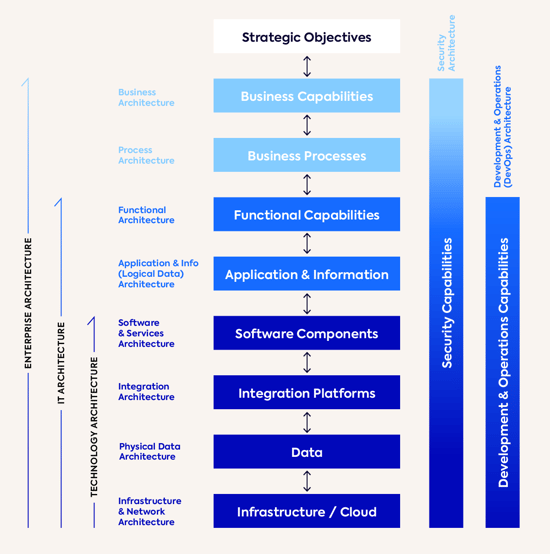Business architecture frameworks and methodologies
In business architecture, frameworks and methods help map and align a company's strategies, processes, and structures.
These frameworks offer structured approaches to design, analyze, and implement business architecture within an organization.
Let's delve into an overview of popular frameworks and how to choose the right one for your organization.
TOGAF (The Open Group Architecture Framework)
- Overview: A comprehensive framework that provides a detailed approach to designing, planning, implementing, and governing an enterprise business architecture.
- Benefits: Offers a holistic approach, encompassing different aspects of an organization, including business, data, application, and technology architectures.
- Suited for: Large organizations looking for a detailed and structured approach to business architecture.
- Overview: A schema is a structured way to view and define a company. It provides a logical structure for organizing and classifying descriptions of an organization.
- Benefits: Provides a disciplined and structured approach to designing and implementing business architecture.
- Suited for: Organizations looking for a foundational framework to understand and document the complexity of their business architecture.
How to choose the right framework?
Selecting the right framework is a critical step in the successful implementation of business architecture. Here are some considerations to help you choose:
- Organizational needs and goals: Understand the specific needs, objectives, and strategic goals of your organization. Different frameworks may cater to different aspects of business architecture.
- Complexity of the business: Consider the complexity of your business. Larger, more complex organizations might benefit from a more detailed and structured framework.
- Resources and expertise: Evaluate the availability of resources and expertise in your organization. Some frameworks may require more intensive training and expertise than others.
- Integration with existing processes: Consider how the framework will integrate with existing processes and systems in your organization. It should complement and enhance, not disrupt, existing workflows.
To implement business architecture effectively, choose the best approach by understanding different frameworks and aligning them with your organization's needs.
Tools and technologies for business architects
In the dynamic field of business architecture, utilizing the appropriate tools and technologies is essential. These tools aid in the meticulous design and documentation of business architecture, fostering enhanced collaboration, streamlined analysis, and informed decision-making.
Below, we delve into the categories of tools that are pivotal for business architects, highlighting both traditional and modern utilities.
Traditional vs. modern tools
Traditional Tools
- Physical models and diagrams: In the past, experts used drawings and models on whiteboards to plan complex business structures.
- Basic documentation tools: Spreadsheets and word processors helped record business architecture, making manual and simple documentation.
Modern Tools
- Collaborative platforms: Business architecture now focuses on platforms that improve collaboration, with real-time updates and smooth communication between teams.
- Cloud-based solutions: Cloud technology allows businesses to easily operate in different regions and setups, thanks to scalable solutions.
📚 Related: Enterprise Architecture Management tool by LeanIX
Categories of tools
1. Enterprise architecture tools
These tools are comprehensive solutions designed to facilitate the design and modeling of business architectures. They offer functionalities such as diagrammatic representation, reporting, and collaboration, providing a one-stop solution for business architects.
2. Diagramming tools
These are specialized tools that aid in creating diagrams, flowcharts, and visual representations of business architectures. The software has user-friendly and teamwork features. It also allows for visual representation of business processes and structures. This is important because it helps to explain complex information clearly and efficiently.
3. Project management tools
These tools are essential in overseeing projects, offering functionalities for tracking progress, managing tasks, and fostering collaboration on projects. They provide a visual representation of tasks and progress, helping teams stay organized and aligned with the project goals.
With the right tools, business architects can design, document, and manage business architectures, aligning with goals and promoting collaboration.
📚 Related: How to Select the Enterprise Architecture Tool?
Certifications
In the competitive landscape of business architecture, acquiring certifications can be a significant asset. Certifications not only validate a business architect's role and skills but also enhance their credibility in the industry.
Here, we explore the importance of certifications and the general pathways one might consider.
Importance of certifications
- Professional credibility: Earning a certification in business architecture can bolster a professional's credibility, showcasing their commitment and expertise in the field.
- Career advancement: Certifications can pave the way for career growth, opening opportunities for higher positions and roles in organizations.
- Skill enhancement: Getting certifications helps professionals improve their skills and stay updated on the latest trends in business architecture.
General pathways to certification
- Foundation courses: Many professionals start with foundation courses that offer a basic understanding of business architecture concepts, principles, and practices.
- Advanced certifications: After learning the basics, professionals can choose advanced certifications that provide specialized training in different areas of business architecture.
- Workshops and seminars: Attending workshops and seminars can boost knowledge and connect with industry peers, besides formal certifications.
- Practical experience: Alongside certifications, accumulating practical experience in business architecture projects is vital. Many certification programs require candidates to have a certain amount of practical experience.
Selecting the right certification program
- Industry recognition: When choosing a certification program, consider its recognition and standing in the industry. Opt for programs that are well-regarded and have a good reputation.
- Curriculum: Check the certification program's curriculum to make sure it includes all important topics and provides thorough business architecture training.
- Flexibility and accessibility: Look for programs that let you learn in different ways, like online, offline, or a mix. Make sure the program is easy to use and lets you balance learning with other things you have to do.
By pursuing certifications in business architecture, professionals can carve out a successful career path, equipped with the knowledge and skills to excel in the field.
Conclusion
Business architecture stands as a cornerstone in organizational strategy, offering a roadmap to align business objectives with operational realities. As you venture deeper into this field, remember that the essence of business architecture lies in fostering agility, clarity, and strategic alignment in organizations.
Whether you are a veteran in the industry or a budding professional, embracing the principles of business architecture can be a gateway to steering organizations toward sustained success and resilience.


/Guide_BC_WhitePaper_Resource_Page_Thumbnail.png?width=400&height=283&name=Guide_BC_WhitePaper_Resource_Page_Thumbnail.png)





